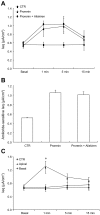Activation of ENaC in collecting duct cells by prorenin and its receptor PRR: involvement of Nox4-derived hydrogen peroxide
- PMID: 26697985
- PMCID: PMC4935776
- DOI: 10.1152/ajprenal.00492.2015
Activation of ENaC in collecting duct cells by prorenin and its receptor PRR: involvement of Nox4-derived hydrogen peroxide
Abstract
The collecting duct (CD) has been recognized as an important source of prorenin/renin, and it also expresses (pro)renin receptor (PRR). The goal of this study was to examine the hypothesis that prorenin or renin via PRR regulates epithelial Na(+) channel (ENaC) activity in mpkCCD cells. Transepithelial Na(+) transport was measured by using a conventional epithelial volt-ohmmeter and was expressed as the calculated equivalent current (Ieq). Amiloride-inhibitable Ieq was used as a reflection of ENaC activity. Administration of prorenin in the nanomolar range induced a significant increase in Ieq that was detectable as early as 1 min, peaked at 5 min, and gradually returned to baseline within 15 min. These changes in Ieq were completely prevented by a newly developed PRR decoy inhibitor, PRO20. Prorenin-induced Ieq was inhibitable by amiloride. Compared with prorenin, renin was less effective in stimulating Ieq Prorenin-induced Ieq was attenuated by apocynin but enhanced by tempol, the latter effect being prevented by catalase. In response to prorenin treatment, the levels of total reactive oxygen species and H2O2 were both increased, as detected by spin-trap analysis and reactive oxygen species (ROS)-Glo H2O2 assay, respectively. Both siRNA-mediated Nox4 knockdown and the dual Nox1/4 inhibitor GKT137892 attenuated prorenin-induced Ieq Overall, our results demonstrate that activation of PRR by prorenin stimulates ENaC activity in CD cells via Nox4-derived H2O2.
Keywords: (pro)renin receptor; epithelial sodium channel; hydrogen peroxide; inner medullary collecting duct; renin activity.
Figures






Similar articles
-
Soluble (pro)renin receptor regulation of ENaC involved in aldosterone signaling in cultured collecting duct cells.Am J Physiol Renal Physiol. 2020 Mar 1;318(3):F817-F825. doi: 10.1152/ajprenal.00436.2019. Epub 2019 Dec 16. Am J Physiol Renal Physiol. 2020. PMID: 31841392 Free PMC article.
-
Collecting duct (pro)renin receptor targets ENaC to mediate angiotensin II-induced hypertension.Am J Physiol Renal Physiol. 2017 Feb 1;312(2):F245-F253. doi: 10.1152/ajprenal.00178.2016. Epub 2016 Apr 27. Am J Physiol Renal Physiol. 2017. PMID: 27122543 Free PMC article.
-
Renal tubular epithelial cell prorenin receptor regulates blood pressure and sodium transport.Am J Physiol Renal Physiol. 2016 Jul 1;311(1):F186-94. doi: 10.1152/ajprenal.00088.2016. Epub 2016 Apr 6. Am J Physiol Renal Physiol. 2016. PMID: 27053687 Free PMC article.
-
Soluble (pro)renin receptor as a novel regulator of renal medullary Na+ reabsorption.Am J Physiol Renal Physiol. 2025 Feb 1;328(2):F239-F247. doi: 10.1152/ajprenal.00156.2024. Epub 2024 Nov 7. Am J Physiol Renal Physiol. 2025. PMID: 39508841 Review.
-
The evolving complexity of the collecting duct renin-angiotensin system in hypertension.Nat Rev Nephrol. 2021 Jul;17(7):481-492. doi: 10.1038/s41581-021-00414-6. Epub 2021 Apr 6. Nat Rev Nephrol. 2021. PMID: 33824491 Free PMC article. Review.
Cited by
-
NOX Inhibitors: From Bench to Naxibs to Bedside.Handb Exp Pharmacol. 2021;264:145-168. doi: 10.1007/164_2020_387. Handb Exp Pharmacol. 2021. PMID: 32780287
-
NOX4-dependent regulation of ENaC in hypertension and diabetic kidney disease.FASEB J. 2020 Oct;34(10):13396-13408. doi: 10.1096/fj.202000966RR. Epub 2020 Aug 16. FASEB J. 2020. PMID: 32799394 Free PMC article.
-
Soluble (pro)renin receptor via β-catenin enhances urine concentration capability as a target of liver X receptor.Proc Natl Acad Sci U S A. 2016 Mar 29;113(13):E1898-906. doi: 10.1073/pnas.1602397113. Epub 2016 Mar 16. Proc Natl Acad Sci U S A. 2016. PMID: 26984496 Free PMC article.
-
Involvement of ENaC in the development of salt-sensitive hypertension.Am J Physiol Renal Physiol. 2017 Aug 1;313(2):F135-F140. doi: 10.1152/ajprenal.00427.2016. Epub 2016 Dec 21. Am J Physiol Renal Physiol. 2017. PMID: 28003189 Free PMC article. Review.
-
OXGR1-Dependent (Pro)Renin Receptor Upregulation in Collecting Ducts of the Clipped Kidney Contributes to Na+ Balance in Goldblatt Hypertensive Mice.Int J Mol Sci. 2024 Sep 18;25(18):10045. doi: 10.3390/ijms251810045. Int J Mol Sci. 2024. PMID: 39337535 Free PMC article.
References
-
- Advani A, Kelly DJ, Cox AJ, White KE, Advani SL, Thai K, Connelly KA, Yuen D, Trogadis J, Herzenberg AM, Kuliszewski MA, Leong-Poi H, Gilbert RE. The (Pro)renin receptor: site-specific and functional linkage to the vacuolar H+-ATPase in the kidney. Hypertension 54: 261–269, 2009. - PubMed
-
- Batenburg WW, Krop M, Garrelds IM, de Vries R, de Bruin RJ, Burckle CA, Muller DN, Bader M, Nguyen G, Danser AH. Prorenin is the endogenous agonist of the (pro)renin receptor. Binding kinetics of renin and prorenin in rat vascular smooth muscle cells overexpressing the human (pro)renin receptor. J Hypertens 25: 2441–2453, 2007. - PubMed
-
- Bens M, Vallet V, Cluzeaud F, Pascual-Letallec L, Kahn A, Rafestin-Oblin ME, Rossier BC, Vandewalle A. Corticosteroid-dependent sodium transport in a novel immortalized mouse collecting duct principal cell line. J Am Soc Nephrol 10: 923–934, 1999. - PubMed
-
- Burckle C, Bader M. Prorenin and its ancient receptor. Hypertension 48: 549–551, 2006. - PubMed
-
- Clavreul N, Sansilvestri-Morel P, Magard D, Verbeuren TJ, Rupin A. (Pro)renin promotes fibrosis gene expression in HEK cells through a Nox4-dependent mechanism. Am J Physiol Renal Physiol 300: F1310–F1318, 2011. - PubMed
Publication types
MeSH terms
Substances
Grants and funding
LinkOut - more resources
Full Text Sources
Other Literature Sources

